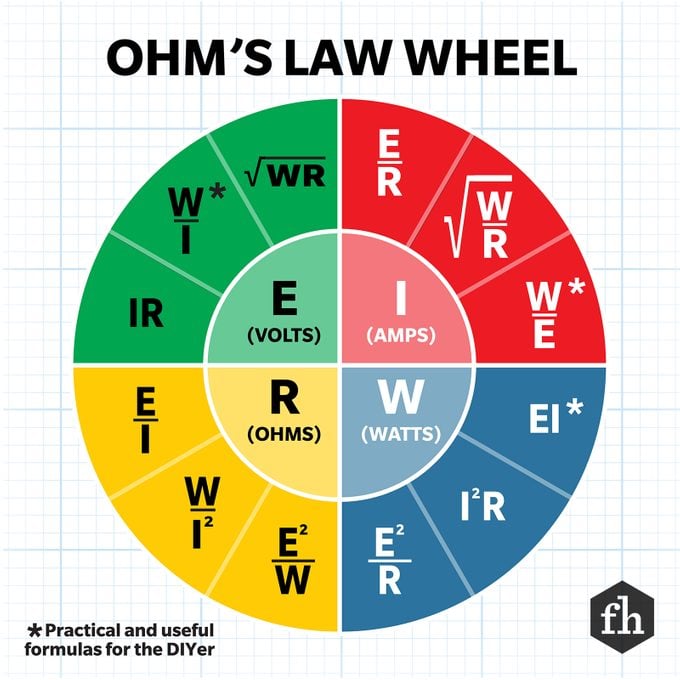Watts, Volts, Amps and Ohms Explained
The basic components of electricity are relatively easy and logical to understand. Most electrical terms relate and get along with each other like a harmonious family. Before you tackle any electrical or home wiring project, familiarize yourself with the following terms so you can go about them smarter, safer and without apprehension.
What Is a Watt?
Watts are units of electric power. Think of wattage as electricity at work when heating or illuminating a room in your home. Take a portable electric space heater rated at 500 watts. The space heater consumes 500 watts of power when it’s turned on.
You’ll also encounter wattage when selecting light bulbs. To find an incandescent bulb that produces equivalent light to the burned-out bulb, you check the wattage. And appliance nameplates are often marked with the product’s wattage rating.
What Is a Volt?
Voltage is the pressure that forces electric current to flow though a wire.
In North America, utility systems typically deliver electricity to your home’s service panel at 240 and 120 volts. Major electrical appliances like ranges, clothes dryers, water heaters, air conditioning and space heating systems typically operate at 240 volts. Everything else runs on 120 volts.
What Is an Amp?
Amperage measures the rate that current flows through an electrical circuit. If voltage is like water pressure, amperage is like the rate of water flow. “Amps” is the common shorthand for this.
When installing, altering or replacing branch circuits in your home, in your electrical panel you’ll see fuses or circuit breakers of different sizes. General-purpose lighting and receptacle outlet circuits are rated 15 amps. In newer construction, you’ll also find dedicated 20-amp circuits for the kitchen, bathroom, laundry room, garage receptacle outlets and appliances like a dishwasher or refrigerator.
Electric clothes dryers and electric water heaters are typically rated 30 amps. Air-conditioning units, electric ranges and electric countertop cooking units or wall-mounted electric ovens may be rated at 30, 40 or 50 amps.
All the electrical components in your home must be coordinated so everything operates safely. The fuse or circuit breaker amp rating dictates the size of the wire and capacity limitations for the circuit. If you need more amps, you need bigger wire.
What Is an Ohm?
An ohm (represented by the Greek letter Omega, or Ω) measures the resistance inherent in any electrical wire. Copper wire, an excellent conductor of electricity, is found throughout many homes. Aluminum wire, another good conductor, can be found in commercial, industrial and utility installations. Both have inherent resistance to the flow of electricity.
Wires made from different metals have different resistance values, just like a small garden hose will limit the flow of water compared to a large fire hose.
When you troubleshoot electrical circuits, appliances, light switches, fuses, relays and other electrical components with a multimeter, some of the settings and readings will be expressed in Ohms. When you check the continuity for a new fuse, the multimeter will read approximately zero Ohms of resistance. That means the fuse has continuity and is good.
On the other hand, if you check a suspected defective fuse or broken light switch, you’ll probably get an Ohm reading other than zero. That may indicate a blown fuse or broken light switch. Consult the multimeter’s user manual so you can operate it safely and interpret the readings.
How Do Watts, Volts, Amps and Ohms Relate to Each Other?
Electrical math is straightforward. If you know two variables, you can find the result. If you know “x” and “y,” you can solve for “z.”
There are many laws in physics, science and nature, and Ohm’s Law is one of the most important in understanding basic electricity. And the Ohm’s Law Wheel helps make sense of it.

Here’s an example of a practical application. Say you’re installing an electric space heater in your garage. There’s a 5,000-watt (five-kilowatt or 5kW) space heater on sale at the hardware store that’s perfect for the space. What size circuit will you need for the space heater?
According to the nameplate, the space heater is rated at 5kW and must be supplied with 240 volts. So you need to solve for the amps (represented by the letter I for “intensity of current”). When you look at the Ohm’s Law Wheel, select this formula:
I = W/E (amps = watts ÷ volts);
I = 5,000 watts ÷ by 240 volts;
I = 20.8 amps;
Because the electric space heater on a continuous load could operate for three or more hours on a cold day, a safety factor of 125 percent is applied. So 20.8 amps x 1.25 = 26 amps.
All done! A standard 30-amp branch circuit will have adequate capacity to supply electricity continuously and safely for the space heater.
How To Work Safely on Your Home’s Electrical System
- Electricity is an invisible phenomenon we take for granted. Working with electricity does not need to be dangerous or difficult if you know how it works, treat it with respect and take basic safety precautions. Learn how to safely use electrical tools and testers.
- Make sure your electrical tester or multimeter is working properly before turning off the power.
- Always turn off power to circuits before working on them. Put a label, sign or circuit breaker lockout device at the electrical panel so nobody inadvertently turns the power back on. You’ll find a variety of universal circuit breaker lockout devices at home centers and online for less than $10.
- Always wear safety glasses and nonconductive leather, rubber, latex, nitrile or similar dry gloves. Wear clothing with natural fibers instead of synthetic materials.
- Wear proper sturdy footwear and never stand or kneel on a wet or damp surface when working with electricity. Use a dry, nonconductive piece of wood or nonconductive mat, especially when working outdoors.
- Use tools with rubber or plastic handles. Nonconductive tool handles provide another level of protection from electrical hazards.
No comments